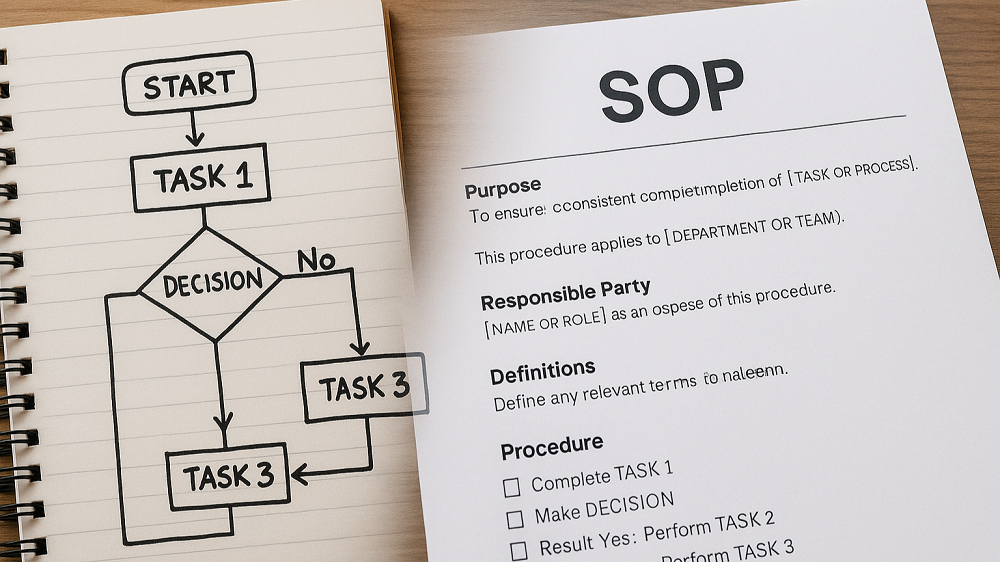Running a small business is full of daily decisions, urgent tasks, and unexpected issues. When everything relies on your memory or personal involvement, it doesn’t take much for things to get chaotic. That’s where SOPs come in.
SOPs, or Standard Operating Procedures, are simple but powerful documents that explain how specific tasks or processes should be done. For small businesses, they’re not just about saving time. SOPs protect your business from costly mistakes, improve team performance, and make growth possible.
What Is an SOP?
An SOP is a written document that outlines the exact steps to complete a task. It answers the questions:
- What needs to be done?
- Who is responsible?
- How do we do it?
- When should it be done?
SOPs can be detailed or simple depending on the task. They’re most helpful when they’re clear, concise, and easy to follow.
Examples include:
- How to onboard a new customer
- How to run payroll
- How to process a return
- How to post to social media
- How to respond to a customer complaint
If something in your business happens more than once, it should probably have an SOP.
Why SOPs Matter for Small Businesses
Many small business owners think SOPs are only for big companies. In reality, small businesses benefit even more because they often have fewer people, tighter budgets, and less margin for error.
Here are some of the biggest pain points SOPs help solve:
1. You’re the Bottleneck
If your team is constantly asking you how to do things or waiting on you to make decisions, you’re the one holding everything up. SOPs let you delegate with confidence.
2. New Hires Take Too Long to Train
Without written procedures, onboarding takes too much time and energy. SOPs allow new employees to learn independently, get up to speed faster, and reduce the risk of costly mistakes.
3. Inconsistency is Hurting Your Brand
When processes are done differently by different people, it affects quality, customer experience, and trust. SOPs create consistency across your business.
4. Important Tasks Are Being Missed
If things slip through the cracks when you’re busy, it’s a sign you need structure. SOPs help your team stay on track, even when you’re not around.
5. You Can’t Scale Without Chaos
Trying to grow without systems just leads to more stress. SOPs are the foundation for scaling smoothly and sustainably.
Benefits of SOPs Beyond Saving Time
Saving time is great, but SOPs deliver a lot more than just efficiency. Here are the deeper benefits:
1. Fewer Mistakes
When everyone follows the same proven process, there’s less room for error. This means fewer re-dos, less customer frustration, and better results.
2. Faster Delegation
You don’t have to explain things over and over. Just hand someone the SOP and let them take ownership. This frees you up to focus on higher-level work.
3. Better Quality Control
When tasks are done the same way every time, it’s easier to maintain standards. This is especially important for customer service, product delivery, and brand consistency.
4. Smoother Team Collaboration
SOPs make it easier for team members to work together. Everyone knows what’s expected, who does what, and how to handle common scenarios.
5. Easier Business Continuity
If someone quits, takes time off, or gets sick, the SOP allows someone else to step in without a huge learning curve. This protects your business from disruption.
6. Higher Profit Margins
Reducing mistakes, saving time, and working more efficiently all lead to higher margins. SOPs directly impact your bottom line by reducing waste and rework.
7. Clearer Decision-Making
SOPs give you a better understanding of how things actually get done. That insight helps you spot bottlenecks, refine processes, and make smarter decisions.
8. Increased Business Value
If you ever want to sell your business or bring on a partner, SOPs add tremendous value. A business with documented systems is far more attractive to buyers and investors.
What Should Be Documented?
The short answer: anything that’s repeated.
Here are common areas where SOPs are especially useful:
Customer service: How to handle complaints, answer common questions, or escalate issues
Sales: How to qualify leads, follow up, send proposals, or close deals
Marketing: How to post to social media, run email campaigns, or update your website
Operations: How to place inventory orders, fulfill customer requests, or check equipment
Finance: How to invoice clients, reconcile accounts, or process payroll
HR: How to onboard, offboard, or conduct performance reviews
You don’t have to create everything at once. Start with the tasks that are causing the most confusion or are critical to the customer experience.
How to Create an Effective SOP
You don’t need a fancy format. What matters most is clarity.
Here’s a simple structure to follow:
1. Title
Make it clear and specific. Example: “How to Send a Weekly Customer Report”
2. Purpose
Explain why this SOP exists. Example: “To ensure clients receive accurate reports every Friday.”
3. Owner
Who is responsible for executing this process?
4. Tools Needed
List any systems, software, or materials required.
5. Step-by-Step Instructions
Write each step in order, using plain language. Include screenshots or examples if helpful.
6. Frequency
How often should this be done? Daily? Weekly? As needed?
7. Review Date
Set a reminder to update it periodically.
Pro Tip: Use screen recording tools like Loom or Scribe to make visual SOPs that show exactly how tasks are performed.
Where to Store Your SOPs
It’s important that your team can actually find and use your SOPs. Some popular options include:
- Google Drive or Dropbox with organized folders
- Notion or Confluence for a more dynamic knowledge base
- A company wiki or internal website
- Printed binders or laminated checklists for physical workflows
Choose whatever method your team will actually use. Consistency matters more than complexity.
How to Get Your Team On Board
The best SOPs are created with input from the people doing the work. That makes them more accurate, more useful, and more likely to be followed.
Here’s how to get buy-in:
- Involve your team in writing or reviewing SOPs
- Explain how SOPs will make their jobs easier
- Make it clear that SOPs are living documents, not rigid rules
- Encourage feedback and improvement over time
Start small and build momentum. Once your team sees the benefits, they’ll be more engaged in creating and maintaining them.
Start with One, Then Build from There
If the idea of documenting everything feels overwhelming, don’t try to do it all at once.
Start with one SOP for a task that causes frequent problems or delays. Use that as a template. As you create more, you’ll build a library of systems that makes your business stronger, more resilient, and easier to run.
Final Thoughts: SOPs Are a Smart Business Owner’s Best Friend
SOPs are not just a way to save time. They’re a way to save energy, reduce stress, protect quality, and make your business more valuable. In a small business, every minute counts. Every mistake costs. Every process has the potential to become smoother and more effective.
By taking the time to document what matters, you create a business that works even when you’re not watching every move. That’s not just efficient. It’s freedom.
Sources:
– U.S. Small Business Administration (SBA) https://www.sba.gov
– Score.org https://www.score.org
– Process Street Blog https://www.process.st/blog
– Harvard Business Review https://hbr.org
– Forbes Small Business https://www.forbes.com/entrepreneurs


